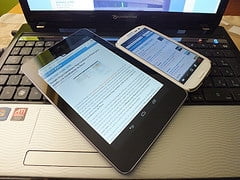 Summary: As technology plays a larger role in all aspects of business, we’re entering a new era of enterprise IT. Yet, research finds that most CIOs are unprepared for these changes. Learn how IT is changing, and a few ways that CIOs must adapt.
Summary: As technology plays a larger role in all aspects of business, we’re entering a new era of enterprise IT. Yet, research finds that most CIOs are unprepared for these changes. Learn how IT is changing, and a few ways that CIOs must adapt.
The role of the IT department is evolving. In the past, IT departments were in charge of keeping the business technology running smoothly.

Now, that’s changing.
How so? The research firm, Gartner, claims that we’re entering the “third era of enterprise IT” known as Digitalization. Industries are being radically reshaped by digital disruption.
In this era, the IT department moves from a back-office function to a true business partner. Rather than simply taking orders from the business, IT will become business drivers.
But, are CIOs prepared to manage this next era? According to Gartner, the answer is “no.” Many IT departments have some work to do before they can step up and become true business drivers.
What needs to change? How can CIOs prepare themselves for this next era of IT? In this age of digital disruption, CIOs must:
Become the technology visionary
For many years, CIOs have focused their efforts on stability. They kept the business technology running smoothly. This often came at the expense of agility.
But, as the pace of technology quickens, stability is no longer good enough. Now, the business also demands agility.
Gartner recently introduced a new model for enterprise IT that addresses this growing need, called “Bimodal IT.”
This concept refers to two modes of IT. Mode 1 is traditional, emphasizing scalability, efficiency, safety, and accuracy. Mode 2 is non-sequential, emphasizing agility and speed.
To reach this point, IT must move beyond the “slow” stereotypes. CIOs must become the visionary that pushes technology forward. Does this mean you must adopt every new technology that comes along? No. But the modern CIO must constantly educate themselves on new technologies and how they impact their business.
“IT leaders need to stay on top of technologies in their industry, which can be difficult when an industry is turned upside down,” says Andre Preoteasa, IT Director at Castle Brands. “Thus, IT managers need to stay on top of a much larger scope of technologies and that is overwhelming. IT is not alone, but in IT the changes are so quick that staying focused paradoxically requires attention to all technologies. How can this be done? Not so simply: the answer is to follow the cutting edge technologies, see what the competitors are doing and take risks. This requires IT leaders to be less hands-on and more integrated into what is going on outside their role and company.”
Make sense of the data influx
Businesses generate (and have access to) more data than ever before. But, is all of this data helping?
According to Reuters “Dying for Business” report, “One-third of managers are victims of ‘Information Fatigue Syndrome.’ 49% said they are unable to handle the vast amounts of information received. 43% think that important decisions are delayed and their abilities to make decisions are affected as a result of having too much information.”
Modern CIOs face a daunting challenge: How can they capitalize on their data? The most successful CIOs in the near future are those that can make sense of this data overload. They’re the ones who can quickly turn this data into meaningful management information.
“The days of IT leaders and CIOs just overseeing the technological needs of companies are rapidly coming to close, even in this current era,” says Tom Hart, COO of the Eliassen Group. “With enterprises of all different types looking to grow their operations and mine Big Data that will allow them to surpass their competitors, IT leaders need to be able to explain – in the clearest terms possible – what that information means and how it can be taken and used to foster growth.”
Manage the multi-platform world

The web has moved beyond the confines of the PC. Employees and customers use an ever-growing array of devices, and this is only expanding.
When a prospect/customer visits your website, you can’t control which device they’ll use.
Modern websites and web applications must account for this new reality. They must deliver the same experience across all platforms.
“The walls between PC and mobile device will fall,” says Cale Dansbee, President / Principal Security Engineer at TOPSTONE. “Users will find it increasingly difficult to tell the difference between an application, app, and webpage.”
Balance data accessibility with security
In the past, data was stored in-house, and locked down. IT controlled data access.
These days, that’s changing. Employee-owned mobile devices have infiltrated the workplace. We’ve entered a mobile world, where employees expect data access from anywhere, on any device.
This problem will only grow. As employees use more devices, and more devices connect to the web, securing data becomes an even bigger challenge.
How can CIOs secure their data while delivering the accessibility required by a mobile workforce?
“IT organizations are under tremendous pressure to support a new class of connected, tech-savvy employees whose expectations for access and ease of use have been shaped by consumer web services,” says John Newton, Co-founder, CTO and Chairman of Alfresco Software. “As a result, users are bypassing company-sponsored IT and adopting consumer-grade services to meet their productivity needs. For example, a recent survey by data security firm Stroz Friedberg found that nearly 75% of information workers in the U.S. share corporate data via cloud file sharing or personal email accounts. These shadow IT solutions often lack the level of control, security, and compliance required for the corporate setting. IT leaders and CIOs must acknowledge this and seek to adopt solutions that meet the needs and desires of this changing workforce and IT environment. Particularly, IT leaders should seek technology that is open, in the cloud and easy to use.”
Deliver future-proof architecture
As cloud-based services mature and new databases and platforms spring up, modern CIOs need fresh thinking about their application architecture. In the past, applications lived in-house. They were often built for a specific database or platform.
Modern application architecture requires a radical shift from this approach. It must prepare a company for any scenario. It must give a company freedom to deploy anywhere–on premise or in the cloud.
In short, the future of IT revolves around agility. If (or when) your company decides to move to a cloud host, your business applications should not hold you back.
“For IT leaders and CIOs, a shift to colocation or managed hosting represents virtually unlimited room for expansion and working with a company that is eager to say “yes” to any request,” says Brian Mitchell, Product Manager – Rack Systems at APC. “This type of transition frees IT manpower to focus on applications rather than monitoring hardware and infrastructure. It also dramatically changes the cash flow for data center managers from intermittent capital expense for new or repaired equipment to a steady, ongoing operating expense that is more predictable and stable.
This potentially impacts the type of experience and training needed by IT team members. Companies can plan for this by implementing applications that are cloud-ready and building a staff with a healthy familiarity with remote and virtual environments more than hardware deployment and infrastructure management.”
So, what do you think? Is there anything you would add to this list? If so, please share your thoughts in the comments.